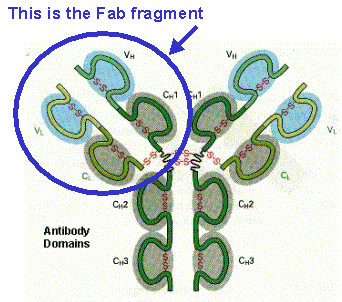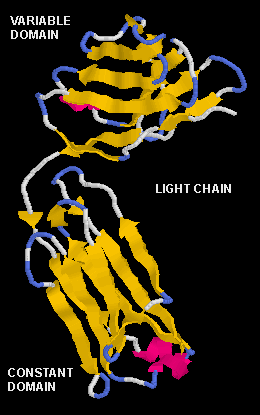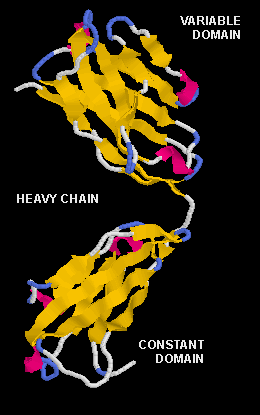Very simple introduction to understanding Fab fragment crystallography
A Fab fragment is a piece of a particular antibody, for example the 2E8 antibody to the LDL receptor binding region of apolipoprotein E. The Fab fragment contains the antigen binding site. As the antibody binding site is the most interesting piece of the rather large antibody, it is of advantage to cleave off the Fab fragment by a papain digest.

The Fab fragment itself contains 2 chains : a light chain (L, the shorter piece in the drawing above) and the heavy chain, H, which continued into the Fc fragment before it was cleaved.


The chains are not seperated as depicted in the simplified sketch. Each chain consists of a two beta sheet sandwiches, one the variable domain (V) and one the constant domain (C). Corresponding domains (VH+VL, CH+CL) are held together by hydrogen bonds and non-hydrophobic interactions. At the N-terminal V domain of both chains are the Complementarity Determining Regions (CDRs) or hypervariable loops which form the antigen binding site.
This is the complete Fab fragment of 2E8, the monoclonal IgG1-kappa antibody specific to the low density lipoprotein (LDL) receptor binding region of apolipoprotein E (ApoE). The actual crystal structure containes 2 molecules of 2E8 Fab molecules in the asymmetric unit (related by non-crystallographic symmetry), and hydrogen bonded through a ß-sheet like intermolecular contact between the heavy chain complementarity determining region 3 (CDRH3) of each molecule.
![]() Back to X-ray Facility Introduction
Back to X-ray Facility Introduction
LLNL Disclaimer
This World Wide Web site conceived and maintained by
Bernhard Rupp (br@llnl.gov)
Last revised April 06, 1999 11:03
UCRL-MI-125269